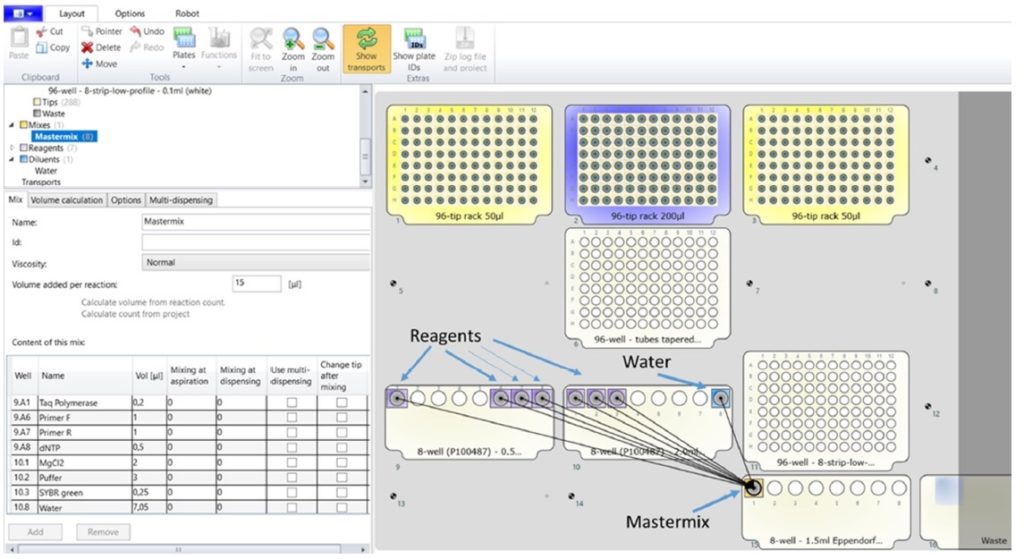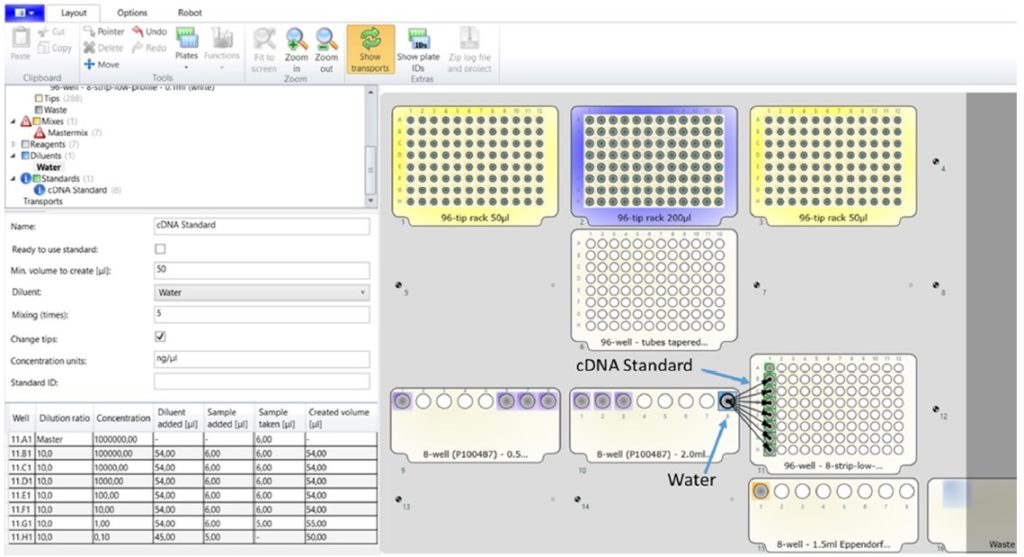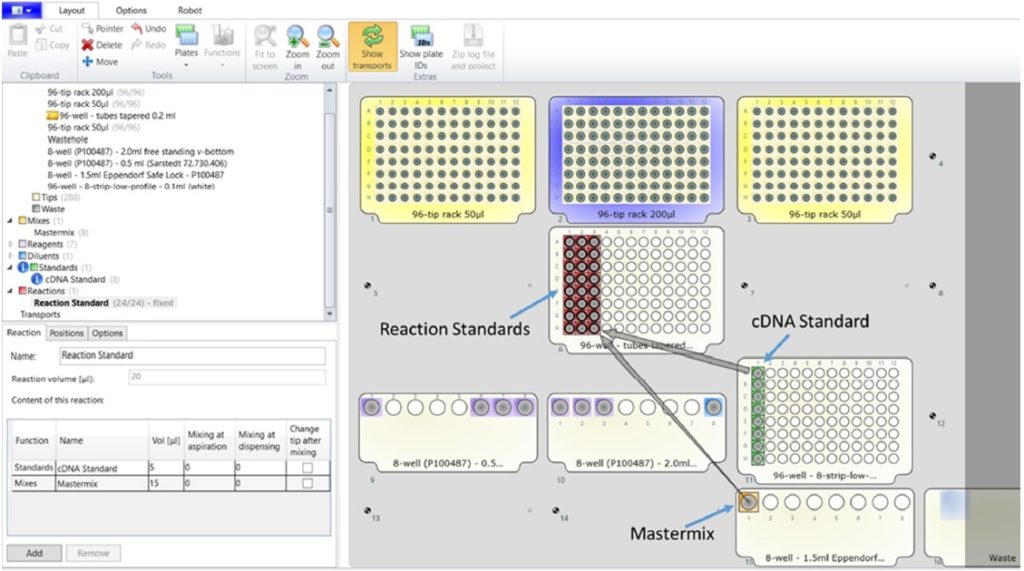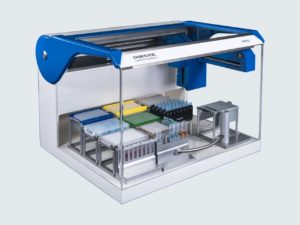By DORNIER LabTech…
Automated qPCR with pipetting PIRO®
Overview
The liquid handling robot PIRO® from DORNIER LabTech Systems makes set up for quantitative polymerase chain reaction (qPCR) intuitively simple, fast and precise. PIRO® is engineered to allow very precise pipetting in PCR and qPCR applications at very small volumes, with no cross contamination and error-free automated processes.
PIRO®’s drag and drop user interface makes it easy to program a specific qPCR protocol, including setting up a Mastermix to guide the reaction series.
Background
The constant challenges of qPCR setup are to process very low volumes precisely, with no risk of confusion and free from contamination. The challenges are made more severe by the very small special vessels with complicated designs involved in most pipetting processes.
Further, the qPCR set-up demands preliminary preparation of a basic ‘mix’ of several components and reagents, typically including:
- DNA template containing the DNA target region for amplification
- Taq or similar DNA polymerase
- Two DNA primers
- Deoxynucleoside triphosphates (dNTPs)
- Buffer solution to promote activity and stability of the DNA polymerase
- Bivalent cations, typically magnesium (Mg) or manganese (Mn) ions
- Monovalent cations, typically potassium (K) ions
The precise composition of this mix is defined for a single model reaction, with total volume of mix then projected across the number of samples to be used in the series.
An effective PCR system should allow easy, intuitive implementation of the reaction setup and further related applications, with a user-friendly interface with inbuilt help functions that supports the operator in creating the program. This should make it possible for even less proficient users to implement desired pipetting protocols very quickly and without errors.
Method
The following shows an example of how the liquid handling system PIRO® makes it quick and easy to set up a qPCR protocol, using drag-and drop programming to reduce set-up to a three-step process.
Step 1: Create PCR Mastermix
The PIRO® software allows the PCR Mastermix to be assembled from a list of predefined components, using Drag & Drop. In this illustration the Mastermix will include primers, PCR buffer, polymerase, dNTPs, MgCl2 and SYBR Green Supermix, combined with one cDNA standard and 32 cDNA samples available in 1.5 ml Eppendorf tubes and used as duplicates. User defines overall Mastermix composition volume for a single 15 μl reaction, with PIRO® software helping to calculate precise amount required for each component, via onscreen alerts and hints. Once mix composition is finalized, PIRO® automatically calculates how much water is required and then total Mastermix volume required for user-defined number of reaction mixtures, allowing for dead volume.
Step 2: Creating the cDNA standard series using the pipetting robot PIRO®
The PIRO® software tool “Create a standard” helps the user to create the dilution series, programming dilutions and cDNA standard in 50 μl mixtures with just a few mouse clicks.
1. Mark positions (and number of dilution steps) for the standard.
2. Right click function “Create a standard” and enter the dilution factor and the volume to be created for each dilution level in the table in the dialog screen. PIRO® software automatically calculates the respective volumes between samples and dilution.
3. Enter mixing cycles and start concentration, allowing automatic pipetting of the standard to begin.
Step 3: Creating the qPCR reaction using the liquid handling robot PIRO®
User can now select pre-programmed Mastermix and Standard series and drag & drop them to the qPCR plate, entering desired sample volume in the dialog screen and assigning desired mix to the target positions.
Now define the mixing of the liquids and the number of replicates (three replicates) to complete programming the standard reactions. Finally, select the cDNA samples in the 1.5 ml vessels and move these to the reaction plate with Drag & Drop. The Mastermix is then added to the reaction with the cDNA samples and the corresponding volume specifications are entered. Select the mixing of the liquids and the number of replicates (two replicates) to complete creating the qPCR reaction.
User can now store the method as a template to be used for subsequent repetitions and also to serve as basis for similar applications.
Summary
The DORNIER LabTech Systems liquid handling robot PIRO® makes it easy to create reliable programs for qPCR assays, creating Mastermixes, standard series, and reaction series with just a few mouse clicks. The intuitive PIRO® software interacts with users and guides them with clear suggestions during programming, avoiding common pitfalls such as confusing samples, forgetting a sample or unintentionally pipetting twice into the same target vessel. When the pipetting protocols for target application are finally created, they can be saved to serve as a template for underlying application and platform for future reaction series.
Resources
Click on DORNIER LabTech Systems PIRO® automates qPCR set-up for more information.
Click on DORNIER LabTech Systems to contact the company directly.
Click on PIRO video to see latest YouTube presentation.
Click on PIRO® automated qPCR set-up for detailed information.
Supplier Information
Supplier: DORNIER-LTF GmbH
Address: Rickenbacher Str. 107, 88131 Lindau, Germany
Tel: +49 8382 2730 890
Fax: +49 8382 2730 8929
Website: www.dornier-ltf.com



















